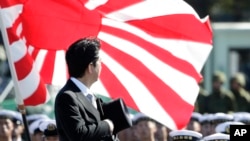On Tuesday South Korea demanded that Japan acknowledge that Korean forced labor was used in the past at some sites that Tokyo would like added to the list of UNESCO World Heritage Sites. The UNESCO controversy is the latest development in a longstanding regional dispute over Japan’s past wartime atrocities.
The 23 sites being considered by UNESCO, the United Nations Educational, Scientific and Cultural Organization, to be added to its World Heritage List include coal mines, steel works and shipyards that exemplify how Japan became the first Asian nation to enter the modern industrial age from 1850 to 1910.
South Korea and China have objected to Japan’s bid because they say it purposely distorts history by ignoring how thousands of Koreans were forced to work at these sites after 1910, when Japan’s military conquered and imposed colonial rule throughout much of Asia.
Recent talks between Seoul and Tokyo on this issue have so far failed to resolve the dispute.
Japan’s Chief Cabinet Secretary, Yoshihide Suga, said the UNESCO nominated sites should be considered separate from the ongoing regional dispute over the atrocities committed during Japan’s military occupation of Asia in the first half of the 20th century.
Suga said they should not politicize this issue.
South Korean and Chinese officials have voiced opposition to seven of these sites, where some 60,000 laborers from Korea and China were reportedly forced to work long hours and under dangerous conditions. Among the sites is the island of Hashima off Nagasaki that was an undersea coal mine. Today it is desolate and virtually uninhabited and was a featured location as a villain’s stronghold in a recent James Bond film.
South Korea and China see Japan’s carefully constructed World Heritage Site narrative that excludes any involvement in past abuse as part of a pattern.
They point out Prime Minister’s Shinzo Abe's reluctance to offer a strong apology for Japan’s wartime atrocities, which include forcing thousands of women into prostitution.
Robert Kelly, an international relations professor at Pusan National University in South Korea, said Japan’s critics have a valid complaint.
“The Koreans are kind of shrill about this and they demonize Japan way too much but I can understand why. The Japanese have a terrible tendency not to admit these kinds of things,” said Kelly.
Prime Minister Abe has said he will uphold statements by past leaders that offered apologies for Japanese misconduct during the war. But he stirred the controversy when he visited a World War II shrine that includes some Japanese war criminals.
South Korean President Park Geun-hye has refused to meet with her Japanese counterpart until he makes a “sincere apology” for past wartime abuse. But at the same time the two Asian democracies continue to cooperate on regional security and trade issues.
The World Heritage Committee is expected to render a decision on Japan’s UNESCO request during a meeting in Germany at the end of June.











